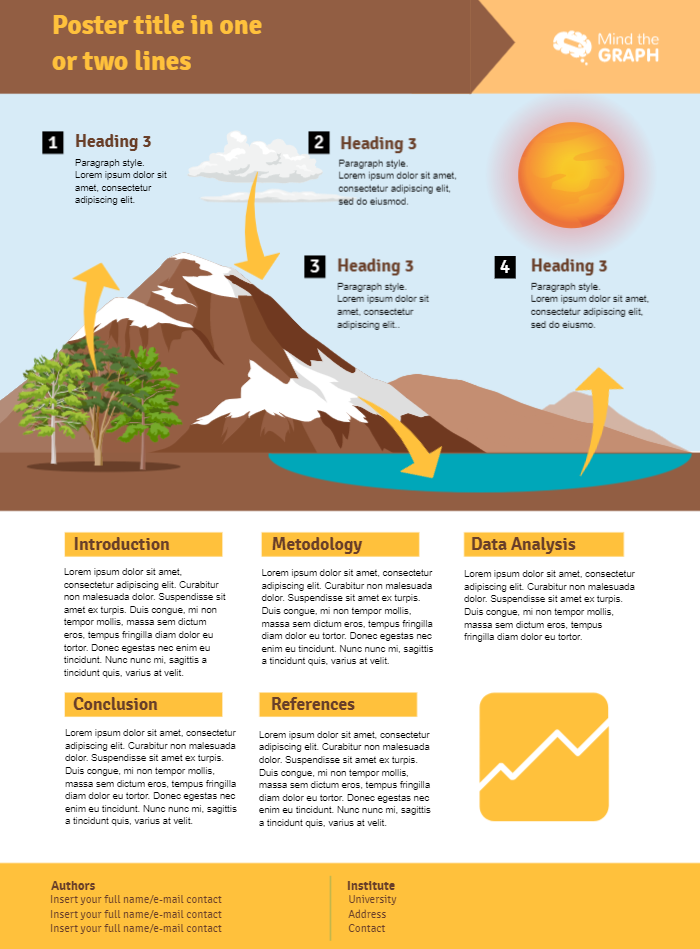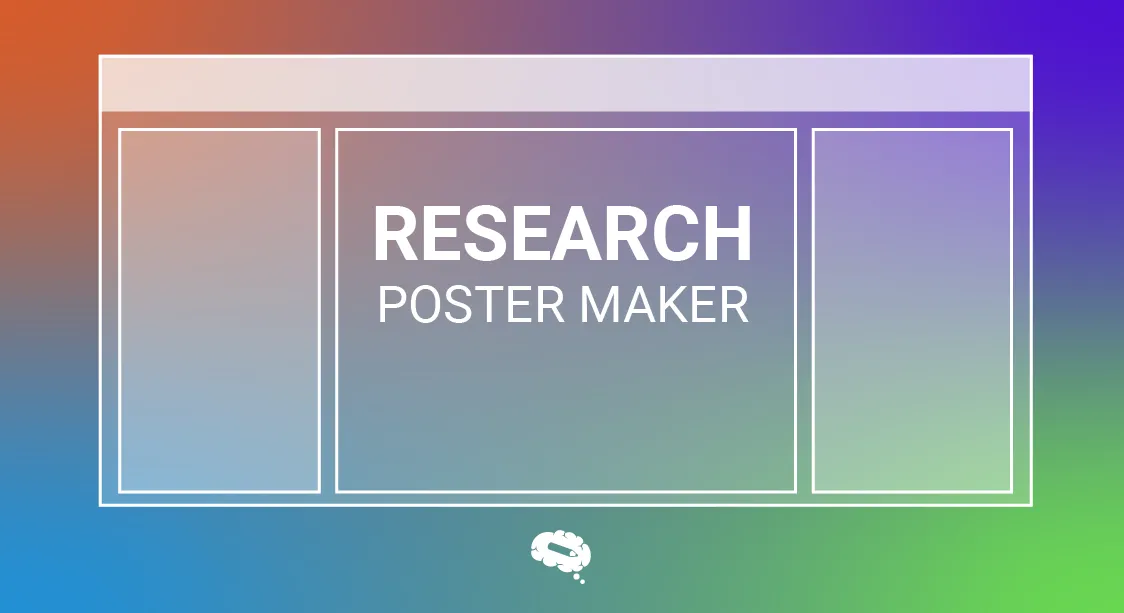Du tror kanskje at plakater og kunstverk ikke er noe for forskere, men det å lage en effektiv forskningsplakat er helt avgjørende når du skal presentere arbeidet ditt på akademiske konferanser. Tenk på plakaten som et visuelt sammendrag av forskningen din.
It’s not just about displaying your findings, it’s about communicating your ideas clearly and engagingly. The goal is to grab attention and make it easy for others to understand your research at a glance. ,
Dette er bare toppen av isfjellet, det er mer ved forskningsplakater enn det man ser ved første øyekast. Så la oss komme i gang med temaet vårt og forstå det dypt!
Hva er en forskningsplakat?
En forskningsplakat er per definisjon et visuelt presentasjonsverktøy som brukes til å oppsummere og kommunisere de viktigste aspektene ved et forskningsprosjekt.
It’s typically displayed at academic conferences, where researchers share their work with others in their field.
The poster includes important sections like the title, introduction, methods, results, and conclusion, all organized in a way that’s easy to read at a glance. The goal of a research poster is to visually showcase your research, making it accessible and engaging for viewers who might be interested in learning more about your work.
Når du lager en forskningsplakat, sammenfatter du hele prosjektet ditt i et format som både er informativt og visuelt tiltalende. Dette betyr at du må fokusere på de viktigste punktene i forskningen din, for eksempel hypotese, metoder, resultater, og konklusjoneruten å overvelde betrakteren med for mye tekst eller komplekse data.
Your poster should be well-organized, with sections clearly labeled so that anyone can quickly follow the flow of information. It’s also important to use visuals like charts, graphs, and images to support your data and make your poster more engaging.
En effektiv forskningsplakat viser ikke bare frem det harde arbeidet ditt, men legger også til rette for meningsfulle diskusjoner og nettverksbygging med fagfeller og eksperter på feltet ditt.
Lag plakaten din ved hjelp av Mind the Graph, og gjør forskningen din levende på få minutter!

Hvordan planlegge forskningsplakaten din?
Forstå publikummet ditt
When planning your research poster, it’s essential to start by understanding your audience. Think about who will be viewing your poster. Are they experts in your field, students, or people with a general interest in your topic? Knowing this helps you tailor your content to match their level of understanding.
For example, if your audience includes non-specialists, you’ll want to avoid jargon and explain complex concepts in simpler terms. If you’re presenting to experts, you can include more detailed data and technical language.
Hovedbudskap
Next, focus on the key message you want to convey. What is the main takeaway from your research? This should be the central idea that anyone who views your poster walks away with. Keep it clear and concise, so it’s easy to grasp even for someone just passing by. Avoid cluttering your poster with too much information; instead, highlight the most critical points that support your key message.
By understanding your audience and refining your key message, you’ll be able to create a research poster that effectively communicates your work and engages viewers, making them want to learn more about your research.
Utforming av layout for forskningsplakater
Organisering av innholdet ditt
When designing the layout of your research poster, it’s important to organize your content in a way that’s easy to follow. Start by dividing your information into clear sections: Title, Introduction, Methods, Results, and Conclusion.
This structure helps guide viewers through your research step by step. Use headings and subheadings to separate each section, making it simple for people to find the information they’re interested in. A well-organized layout ensures your poster is not only informative but also easy to navigate.
Visuelle elementer
I tillegg til å organisere innholdet ditt, visuelle elementer spiller en avgjørende rolle for å gjøre plakaten din engasjerende. Ved å inkludere diagrammer, grafer og bilder kan du illustrere poengene dine og gjøre komplekse data mer tilgjengelige.
Visuelt materiale kan bryte opp teksten og rette oppmerksomheten mot viktige funn. Sørg imidlertid for at bildene du velger, er relevante og enkle å forstå.
Bruk for eksempel tydelige etiketter på diagrammer, og sørg for at bildene er av høy kvalitet. Unngå å overfylle plakaten med for mange bilder, og fokuser i stedet på de som best støtter hovedbudskapet ditt.
By organizing your content and using effective visual elements, you’ll create a research poster that is both visually appealing and easy for your audience to comprehend.
Skrive innhold til forskningsplakater
Tittel og innledning
When writing the content for your research poster, it’s important to be clear and concise. Start with a title that captures attention. Your title should give viewers a quick idea of what your research is about, so make it catchy and relevant.
After the title, write a brief introduction that sets the context of your research. Explain why your research is important and what problem it addresses, but keep it short—just enough to give your audience a foundation.
Metoder og resultater
Deretter beskriver du metodene du har brukt i forskningen din. Denne delen bør være enkel og forklare hvordan du har gjennomført studien. Hold det enkelt, men sørg for at du inkluderer nok detaljer til at publikum kan forstå prosessen din.
Etter metodene presenterer du de viktigste funnene i resultatdelen. Bruk støttedata for å underbygge funnene dine, og vurder å bruke visuelle virkemidler som diagrammer eller grafer for å gjøre dataene mer forståelige.
Konklusjon
Finally, in conclusion, summarize the main points of your research. Highlight the implications of your work—what do your findings mean, and why do they matter? Keep your conclusion brief, but make sure it leaves your audience with a clear understanding of the significance of your research.
Les også: Hvordan lage en plakat til en forskningspresentasjon

Siste ting å tenke på i forbindelse med forskningsplakaten
When you’ve finished creating your research poster, it’s time to focus on the final touches. These steps can make a big difference in how your poster is received and how confident you feel presenting it.
Korrekturlesing
Det første trinnet er korrekturlesing. You want to make sure that your poster is free of spelling and grammatical errors. Even small mistakes can detract from the professionalism of your work. Carefully review every section of your poster, and don’t rush this process.
It can be helpful to read your text out loud to catch errors you might overlook when reading silently. If possible, ask a friend or colleague to review your poster as well—they might spot something you missed.
Tydelighet og lesbarhet er også viktig. Plakaten din bør være lett å forstå, selv for en som ikke er ekspert på fagfeltet ditt. Unngå å bruke et altfor komplisert språk eller sjargong som kan forvirre publikum.
Hold setningene korte og poengterte, og sørg for at ideene dine flyter logisk fra én del til den neste. Målet er å sikre at alle som ser plakaten din, raskt kan forstå hovedpoengene i forskningen din.
Øve på presentasjonen din
Once your poster is polished, it’s time to prepare for the presentation. Even though your poster will do much of the talking, you should be ready to explain your work in person to anyone who shows interest.
Practice giving a brief summary of your research—think of it as an elevator pitch that you can deliver in just a few minutes. You should be able to walk someone through your poster, highlighting the key points and answering any questions they might have.
It’s also important to anticipate potential questions and rehearse your answers. Think about the aspects of your research that might spark curiosity or need further clarification. Practice responding to questions about your methods, results, and the implications of your work.
Hvis du er godt forberedt, vil du føle deg tryggere under presentasjonen og få en mer effektiv dialog med publikum.
Remember, your poster presentation is an opportunity to showcase your hard work and connect with others in your field. By proofreading your poster thoroughly and practicing your presentation, you’ll be ready to make a strong impression and communicate your research clearly. These final touches can turn a good poster into an excellent one, making sure that your work is presented in the best possible light.
Konklusjon
Når du skal ferdigstille forskningsplakaten din, må du lese nøye korrektur for å eliminere feil og sikre klarhet. Innholdet bør være lett å lese og forstå, og det bør være fritt for komplisert språk.
Additionally, practicing your presentation will prepare you to confidently explain your work and answer questions. By focusing on these final touches, you’ll enhance the professionalism of your poster and make a lasting impression on your audience. These steps ensure that your hard work is effectively communicated and well-received.
Les også: Den ultimate guiden: Slik lager du en forskningsplakat som skiller seg ut
Skill deg ut på ethvert arrangement eller i ethvert miljø med visuelt imponerende plakater
Hater du å høres kjedelig ut når du presenterer forskningen din? Hater du å se publikum gjespe konstant mens du står på scenen og presenterer arbeidet ditt? Hvis du er på utkikk etter løsninger for å holde publikum engasjert samtidig som du ikke mister sjarmen ved forskningsarbeidet ditt, bør du vurdere visuell historiefortelling. Ja, vi snakker om visuelle virkemidler i form av illustrasjoner og infografikk.
You can now stand out at any event with visually stunning posters by using a simple tool – Mind the Graph. Registrer deg nå for å utforske vårt bibliotek med vitenskapelige maler som kan hjelpe deg med å forbedre arbeidet ditt.


Abonner på nyhetsbrevet vårt
Eksklusivt innhold av høy kvalitet om effektiv visuell
kommunikasjon innen vitenskap.

